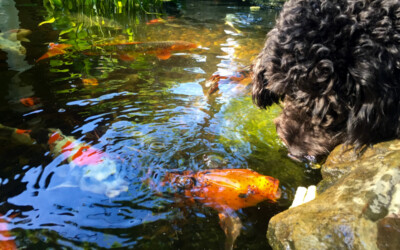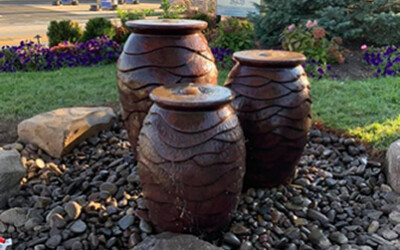Pump Selection Guide for Ponds, Waterfalls and Fountains
Your pump is the heart of your water feature’s circulation system. The right pump will give you a perfect flow of water and run trouble-free for years. This guide will help you find the perfect pump for your pond, waterfall or fountain. Let’s start with how you plan to use your pump.
Choose one of the options below to get started.
How to Choose the Right Size Pump for a Fountain
Choosing a pump for a fountain is usually as simple as locating the manufacturer’s recommended flow rate and finding a pump that matches.
Our Statuary and Fountain submersible pumps are perfect for smaller fountains and spitters.
For bigger fountains, Ultra Pumps are available in six sizes, ranging from 400 to 2,000 gallons per hour.
Our Aquasurge Pumps come in standard and adjustable flow models for the largest fountains. Flow rates range from 2,000 to 8,000 gallons per hour
How to determine Gallons Per Hour (GPH) Flow Rate:
• If you are replacing an existing pump, look for a label indicating the GPH and choose a pump below that offers the same flow rate.
•If you need a pump for a new fountain, check the manufacturer’s recommended gallons per hour flow rate abbreviated as GPH
• If you can’t locate the recommended GPH, Contact us, and our team of experts will help you find the perfect pump for your project.
Fittings and Tubing Size
You’ll also need to take note of the diameter of your tubing/pipe and make sure it can be connected to the new pump’s discharge attachment. Our pumps come with multiple options for connecting different size tubing.
STATUARY PUMPS
70 - 320 GPH
- Perfect for small fountains and ornamental spitters
- Includes a protective intake strainer, adjustable flow control, energy-efficient mag-drive motor and a 6-foot power cord
- Pump Discharge Fittings 1/2, 5/8 inch
- 3-year warranty
ULTRA PUMPS
400 - 2,000 GPH
- Ideal for most larger fountains
- Included Fittings attach to a range of pipe diameters (1/2″ to 1-1/4″, depending on specific model)
- Includes a protective intake strainer, energy-efficient mag-drive motor and 12- or 25-foot power cord (depending on model)
- 3-year warranty
AQUASURGE PUMPS
2,000+ GPH
- Adjustable flow rate pump for the largest fountains
- Smart Control App lets you adjust the flow right from your phone
- Threaded 1.5″ outlet with Rotational Ball Adapter works with pipe diameters from 1″ – 2″
- 3-year limited warranty
How to Choose the Right Size Pump for a Pond or Disappearing Waterfall
To choose the right pump, you’ll need to know the Target Flow Rate and the Pump Head Pressure.
- Target Flow Rate: This is the volume of water described in Gallons Per Hour (GPH) that the pump will be pushing through the plumbing and over your waterfall.
- Pump Head Pressure: This measurement takes into account the height and distance the water needs to travel, plus the friction from the pipe walls and fittings it encounters along the way.
The wrong pump will result in higher electrical cost, short lived pumps, or not enough water flow.
Let’s get started with Measuring the Pond and then we’ll Calculate the Target Flow Rate.
Step 1: Measure the Pond
- Longest length: the biggest distance from one end of the pond to the other (in feet)
- Average width (in FEET)
- Average depth (in FEET)
- Width of widest waterfall (in INCHES)
- Height of highest waterfall (in FEET) ► Important Note: This is the elevation change from TOP of the water in the Pond or Basin to the TOP of the water in the waterfall.
Ponds often have funky shapes, so it’s OK to estimate – just round up to ensure adequate circulation.
We’ll do the math for you in the Flow Rate Calculator in the next step below. Here’s the formula we use to find the total estimated gallons in your pond:
Pond length (ft.) x average width (ft.) x average depth (ft.) x 7.48 x 0.8
Step 2: Calculate Target Flow Rate
Using the measurements above, you can use this calculator to find the Ideal or Target Flow Rate for your pond.
The largest of these numbers will be our final Target Flow Rate.
If you have a Disappearing Waterfall, just use the width of the widest waterfall. You can ignore the turnover and skimmer-distance measurements.
Target Flow Rate Calculator
Make a note of the Ideal Flow Rate listed above.
This is your Target Flow Rate.
- 2/Hour Turnover: For typical ecosystem ponds, the pump should circulate the entire pond water volume twice or more per hour. (Larger ponds often need slightly less, and Ecosystem Recreation or Swim Ponds might need more to ensure optimum water quality.)
- 3,000 GPH per 10′ Distance from Skimmer: We want to make sure that debris flows efficiently into the skimmer basket, and doesn’t drop to the bottom of the pond. If you have lots of debris – i.e. the pond is in a heavily wooded area – then you might need an even higher flow rate.
- 150 GPH per 1″ of Width of the Widest Waterfall: Wider waterfalls need a higher flowrate to look their best and ensure good oxygenation for fish. While 150 GPH/1″ is a good rule of thumb for most ponds, you might want more or less depending on if you want crashing falls or a tranquil trickle.
We’ll use this number in the pump chart at the end to find the perfect pump.
Step 3: Calculate Pump Head Pressure
Pump Head Pressure Calculator
Read more to learn about Pump Head Pressure
Pump Head Pressure is the sum of the water feature’s Static Head Pressure and Dynamic Head Pressure. Knowing this number is crucial for estimating your pump’s flow rate (GPH) in your pond or waterfall.
- Static Head Pressure is the weight (pressure) of the water in the pipe and plumbing above the pump. To find Static Head, measure the vertical distance between the TOP of the water in the pond (or basin in a disappearing waterfall) to the TOP of water in the highest waterfall. Pond depth does not affect Static Head Pressure. See the graphic above.
- Dynamic Head Pressure is the friction water encounters as it is pumped through the pipe and plumbing. Pipe diameter, pipe length, and fittings – like elbows and valves – will affect this measurement. If you have a lot of fittings – or if you want a more accurate calculation – click here to determine the amount of friction caused by each fitting, then type that number into the designated spot in the calculator.
Adding Static and Dynamic pressures will give you the Total Head Pressure for your pond or waterfall pump. We’ll use this number in the pump chart at the end to find the perfect pump.
Final Check... Pipe Details
Just two quick checks ...
Our Professional Grade Flex PVC is awesome tough stuff, but all pipes will have some limitations. It is possible the flow rate calculators in previous steps will result in numbers that are note physically possible in an ecosystem pond.
1. Max Flow Rates for Pro FLEX PVC Pipe
Pipe diameter restricts the Flow Rate/GPH, no matter how big the pump is. Double check that your pipe is big enough to handle your Target Flow Rate.
1.5″ = 2,200 GPH
2″ = 4,800 GPH
3″ = 10,500 GPH
2. Water Velocity Calculator
Velocities of more than 7 feet per second are not possible. Double check and make sure the Flow Velocity is less than 7 ft/s.
If velocity is too high, try a larger diameter pipe or try splitting your flow into separate pipes.
Step 5: Putting It All Together
Most Pond Pumps have a “flow rate” number printed in a large font on the front of the box. Although this helps to differentiate the pumps on the shelf, this is probably not the actual flow rate you will achieve in your pond or waterfall.
We need to take a closer look at the “Pump Curve” chart that is on the back of the box.
For example, the Aquasurge 2000 Pond Pump has a flow rate of approx 2000 GPH at around 3 feet of Head. Anything more than than 3 feet results in flow rates less than 2000 GHP. At the “Max Head Height” of 12.5′ the flow will be ZERO.
In the chart below, move the red slider to the Total Application Head from Step 3 above.
Scroll down the list of pumps to find your Target Flow Rate (from Step 2) in the dark green “Best Operating Zone”.
Pond & Waterfall Pump Guide
Pumps in the Best Operating Zone will be the most efficient and long lasting pump for your specific pond or waterfall. Select the pump family below and visit our online store for detailed specifications and model information.
Location: Skimmer or Waterfall Vault
Max Waterfall Height: 5′
Benefits: Energy-efficient, reliable, adjustable flow/WiFi compatible options available
Motor: Asynchronous
Cord Length: 20′
Ideal Pipe Diameter: 1.5″-3″, depending on model
Warranty: 3 Years
Location: Skimmer or Waterfall Vault
Max Waterfall Height: 5′
Benefits: Max energy efficiency, most budget-friendly
Motor: Mag-Drive
Cord Length: 20′
Ideal Pipe Diameter: 1.5″-2″, depending on model
Warranty: 3 Years
Location: Skimmer or Waterfall Vault
Benefits: Adjustable flow, solids-handling, WiFi compatible
Motor: Asynchronous
Cord Length: 20′
Ideal Pipe Diameter: 2″-3″, depending on model
Warranty: 3 Years
Location: Skimmer or Waterfall Vault
Benefits: Solids-handling, max power
Motor: Direct Drive
Cord Length: 20′
Ideal Pipe Diameter: 1.5″-3″, depending on model
Warranty: 2 Years
Location: Directly in Pond
Benefits: Protective cage makes this pump ideal for use in ponds that do not have traditional skimmers
Motor: Asynchronous
Cord Length: 25′
Ideal Pipe Diameter: 1″-3″, depending on model
Warranty: 3 Years
Location: Directly in Pond
Benefits: Similar to AquaForce, but includes a small fountain head
Motor: Mag-Drive
Cord Length: 25′
Warranty: 2 Years

